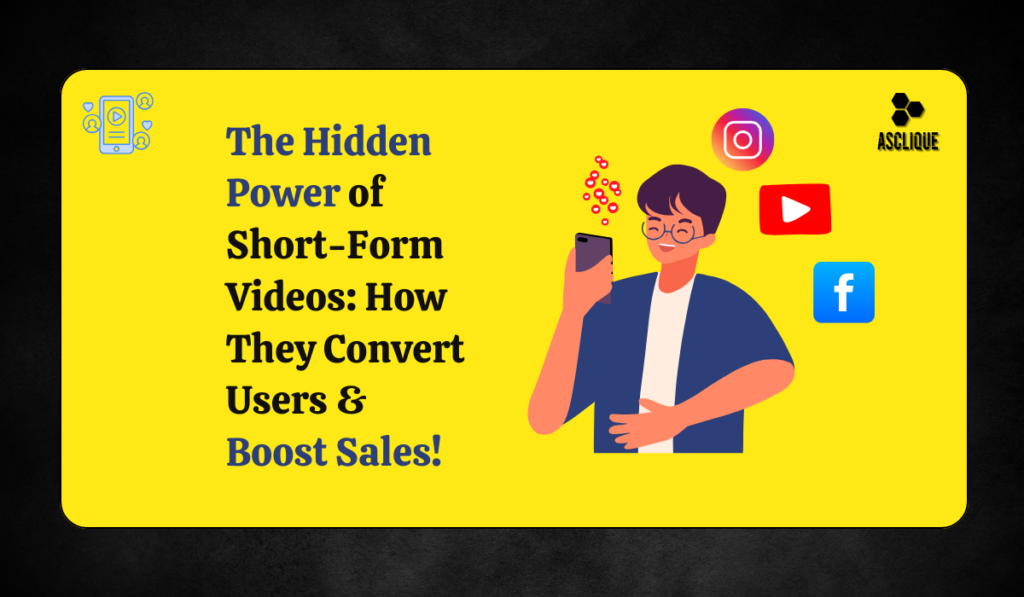Short videos have taken over digital space. With TikTok, Instagram Reels, and YouTube Shorts dominating social media, brands and marketers are leveraging these short videos to engage with humans. But the question remains: Does short-form videos convert users?Although they undoubtedly increase exposure and interaction, converting views into concrete actions—like sign-ups, sales, or inquiries—is the true difficulty. In this post, we’ll examine how well short-form films increase conversions, identify important optimization techniques, and determine whether or not they actually affect user behavior. Let’s find the truth behind their results.
The Rise of Short-Form Video Content
The attention span of an online user has declined drastically, and short videos are the perfect method of grabbing attention. Studies show that viewers like to watch and consume content that is less than 60 seconds compared to long content. This has forced brands to include short videos in their marketing strategy. But does short-form videos convert users? The answer is in their ability to engage users. The attention span of an online user has declined drastically, and short videos are the perfect method of grabbing attention. Studies show that viewers like to watch and consume content that is less than 60 seconds compared to long content. This has forced brands to include short videos in their marketing strategy. But does short-form videos convert users? The answer is in their ability to engage users.
How Short-Form Videos Drive Conversions
Short-form videos not only entertain but also they have the power to influence purchasing decisions and drive user actions. Let’s see how:
Instant Engagement and Retention
Humans are more visually literate and learn faster through images than through text. A good short video can engage within seconds, and messages are simpler to convey. Even with high engagement, does short-form video convert users to customers? It all depends on how content has been strategized. Converting passive viewers into paying customers depends on a number of factors, including platform-specific trends, audience targeting, video duration, and obvious call-to-actions (CTAs). Even the most captivating video may fall short of producing significant outcomes in the absence of a systematic strategy. In order to make sure that their short-form movies inspire action and increase conversions, organizations need to concentrate on both creativity and strategy.
Call-to-Action (CTA) Enhancement
Since short videos should be short and impactful, marketers prefer to use strong CTAs like:
- “Swipe up to buy!”
- “Click the link in bio!”
- “Subscribe now for more!”
This straightforward strategy is more likely to get users to act, answering: Does short-form video convert users? Yes—if accompanied by a clear and compelling CTA.
Also Read: The Rise of Video Content in Social Media Marketing Careers
Originality and Trust-Building
Short-form videos often feature real people, behind-the-scenes content, or customer refrences. This builds originality and helps initiate trust, making users more likely to convert.
Credibility is also increased by displaying staff insights, user-generated content (UGC), or live testimonials. Social proof is created when prospective buyers see actual user experiences, which strengthens brand trust. Delivering insightful and open material on a regular basis helps companies build lasting relationships and raises conversion rates.
Algorithmic Boost from Social Platforms
Platforms such as Instagram, TikTok, and YouTube favor short-form video content in their algos. This means greater organic reach, higher engagement, and more visibility for your brand—giving you greater chances at conversion. But do short-form videos convert users because of visibility alone? Not necessarily—content still has to be optimized for conversions. This consists of intriguing narratives, unambiguous messaging, and powerful calls to action that motivate viewers to act. In order to convert views into real conversions, other important factors include video length, audience targeting, captioning, and interactive aspects. The best outcomes will be achieved by brands who prioritize both exposure and conversion-driven content.
Industries Benefiting the Most from Short-Form Video Conversions
Some industries are seeing incredible success using short-form videos for conversions, including:
- E-commerce – Showcasing products in action with direct purchase links.
- Education & Coaching – Engaging explainer videos and mini-courses.
- Fitness & Wellness – Quick workout demos and health tips.
- Tech & SaaS – Tutorials and feature breakdowns for apps and software.
Challenges & How to Overcome Them
While short-form videos have high engagement rates, not all content converts well. Here’s why and how to fix it:
- Lack of Strategy → Always define a goal before creating videos (brand awareness, lead generation, direct sales, etc.).
- Weak CTAs → Make sure to add a clear and compelling CTA at the end of every video.
- Not Targeting the Right Audience → Use analytics to refine and reach the most relevant audience.
Getting the Most Conversions Out of Short-Form Videos
Businesses must make the most of every segment of their short-form video content to get the highest conversion rates:
- To grab attention right away, involve the audience inside the first three seconds.
- To keep viewers interested, videos should be brief but educational.
- Polls, click-through links, and Q&A stickers are examples of interactive tools that should be used to engage people.
- Try out different video formats, captions, and calls to action to see what your audience responds to the most.
- Keep an eye on performance metrics, and modify material based on user behavior trends.
- In terms of trends and platform algorithmic changes for greater reach and conversion, try new things and never stop innovating.
Businesses may use these strategies to make short movies a powerful tool for increasing conversions.
Conclusion:
Short-form films are more than just a fad; when used properly, they are an effective marketing tool that can engage people, develop trust, and drive conversions. Short films may be transformed into a very successful conversion strategy by organizations by concentrating on essential components like strong hooks, interactive features, and data-driven optimization.
Brands must constantly evaluate performance, try out various content forms, and adjust their strategy in response to audience behavior if they want to succeed. A key element of any effective engagement and conversion strategy will continue to be short-form videos as digital marketing develops. Embrace this format now and begin to take advantage of everything that it has to offer!
FAQs
Are consumers effectively converted by short-form videos?
Yes, if done in a calculated manner. If short-form films have a compelling hook, captivating narrative, and an obvious call-to-action (CTA) that encourages viewers to take the next action—like buying a product or registering for a service—they may immediately capture attention and increase conversion rates.
Which systems work best for converting short-form videos?
Facebook Reels, YouTube Shorts, Instagram Reels, and TikTok are the best platforms for converting short-form videos. When properly configured, these platforms’ algorithms provide preference to short videos, expanding reach and engagement and perhaps enhancing conversion rates.
Which short-form video formats result in the highest conversion rates?
The following short-form videos usually have the highest conversion rates:
- Product demos showing features in action.
- Customer Reviews that build trust and credibility.
- Behind-the-scenes content that makes brands more relatable.
- Educational or tutorial videos that foster value while subtly promoting a product or service.
- Limited-time offers or promotions to create urgency
How can brands make their short videos stand out ?
- Use eye-catching visuals and engaging captions.
- Start with a strong hook within the first three seconds to grab attention.
- Incorporate storytelling to make content more relatable.
- Leverage user-generated content (UGC) to build trust.
- Experiment with humor, emotion, or surprises to keep users engaged.
A unique approach helps brands differentiate themselves in a crowded digital space.

